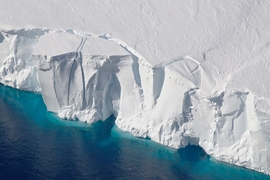Antarctica’s ice sheet spans close to twice the area of the contiguous United States, and its land boundary is buttressed by massive, floating ice shelves extending hundreds of miles out over the frigid waters of the Southern Ocean. When these ice shelves collapse into the ocean, they expose towering cliffs of ice along Antarctica’s edge.
Scientists have assumed that ice cliffs taller than 90 meters (about the height of the Statue of Liberty) would rapidly collapse under their own weight, contributing to more than 6 feet of sea-level rise by the end of the century — enough to completely flood Boston and other coastal cities. But now MIT researchers have found that this particular prediction may be overestimated.
In a paper published today in Geophysical Research Letters, the team reports that in order for a 90-meter ice cliff to collapse entirely, the ice shelves supporting the cliff would have to break apart extremely quickly, within a matter of hours — a rate of ice loss that has not been observed in the modern record.
“Ice shelves are about a kilometer thick, and some are the size of Texas,” says MIT graduate student Fiona Clerc. “To get into catastrophic failures of really tall ice cliffs, you would have to remove these ice shelves within hours, which seems unlikely no matter what the climate-change scenario.”
If a supporting ice shelf were to melt away over a longer period of days or weeks, rather than hours, the researchers found that the remaining ice cliff wouldn’t suddenly crack and collapse under its own weight, but instead would slowly flow out, like a mountain of cold honey that’s been released from a dam.
“The current worst-case scenario of sea-level rise from Antarctica is based on the idea that cliffs higher than 90 meters would fail catastrophically,” Brent Minchew, assistant professor in MIT’s Department of Earth, Atmospheric and Planetary Sciences. “We’re saying that scenario, based on cliff failure, is probably not going to play out. That’s something of a silver lining. That said, we have to be careful about breathing a sigh of relief. There are plenty of other ways to get rapid sea-level rise.”
Clerc is the lead author of the new paper, along with Minchew, and Mark Behn of Boston College.
Silly putty-like behavior
In a warming climate, as Antarctica’s ice shelves collapse into the ocean, they expose towering cliffs of grounded ice, or ice over land. Without the buttressing support of ice shelves, scientists have assumed that the continent’s very tall ice cliffs would collapse, calving into the ocean, to expose even taller cliffs further inland, which would themselves fail and collapse, initiating a runaway ice-sheet retreat.
Today, there are no ice cliffs on Earth that are taller than 90 meters, and scientists assumed this is because cliffs any taller than that would be unable to support their own weight.
Clerc, Minchew, and Behn took on this assumption, wondering whether and under what conditions ice cliffs 90 meters and taller would physically collapse. To answer this, they developed a simple simulation of a rectangular block of ice to represent an idealized ice sheet (ice over land) supported initially by an equally tall ice shelf (ice over water). They ran the simulation forward by shrinking the ice shelf at different rates and seeing how the exposed ice cliff responds over time.
In their simulation, they set the mechanical properties, or behavior of ice, according to Maxwell’s model for viscoelasticity, which describes the way a material can transition from an elastic, rubbery response, to a viscous, honey-like behavior depending on whether it is quickly or slowly loaded. A classic example of viscoelasticity is silly putty: If you leave a ball of silly putty on a table, it slowly slumps into a puddle, like a viscous liquid; if you quickly pull it apart, it tears like an elastic solid.
As it turns out, ice is also a viscoelastic material, and the researchers incorporated Maxwell viscoelasticity into their simulation. They varied the rate at which the buttressing ice shelf was removed, and predicted whether the ice cliff would fracture and collapse like an elastic material or flow like a viscous liquid.
They model the effects of various starting heights, or thicknesses of ice, from 0 to 1,000 meters, along with various timescales of ice shelf collapse. In the end, they found that when a 90-meter cliff is exposed, it will quickly collapse in brittle chunks only if the supporting ice shelf has been removed quickly, over a period of hours. In fact, they found that this behavior holds true for cliffs as tall as 500 meters. If ice shelves are removed over longer periods of days or weeks, ice cliffs as tall as 500 meters will not collapse under their own weight, but instead will slowly slough away, like cold honey.
A realistic picture
The results suggest that the Earth’s tallest ice cliffs are unlikely to collapse catastrophically and trigger a runaway ice sheet retreat. That’s because the fastest rate at which ice shelves are disappearing, at least as documented in the modern record, is on the order of weeks, not hours, as scientists observed in 2002, when they captured satellite imagery of the collapse of the Larsen B ice shelf — a chunk of ice as large as Rhode Island that broke away from Antarctica, shattering into thousands of icebergs over the span of two weeks.
“When Larsen B collapsed, that was quite an extreme event that occurred over two weeks, and that is a tiny ice shelf compared to the ones that we would be particularly worried about,” Clerc says. “So our work shows that cliff failure is probably not the mechanism by which we would get a lot of sea level rise in the near future.”
This research is supported, in part, by the National Science Foundation.











